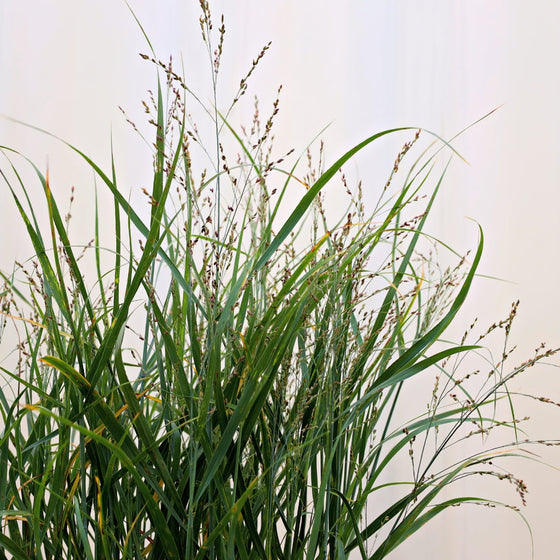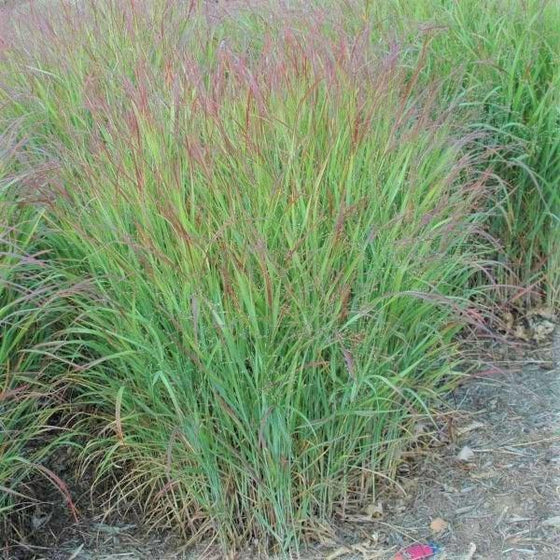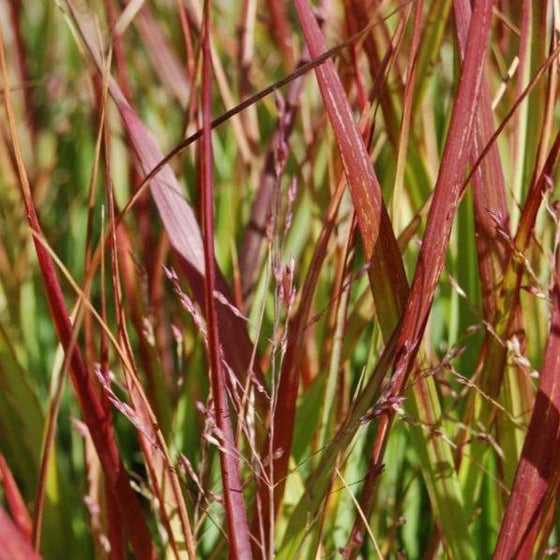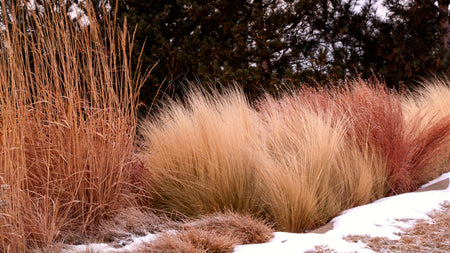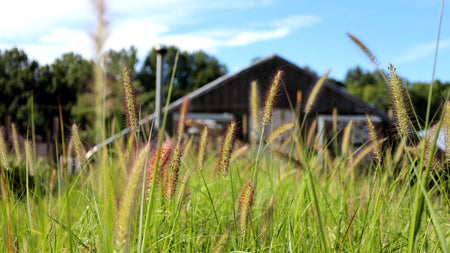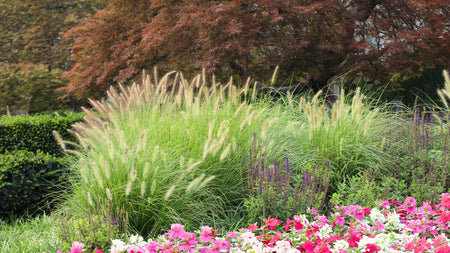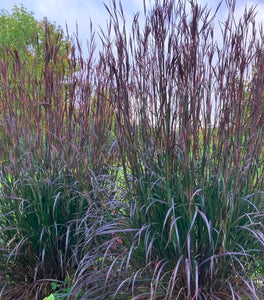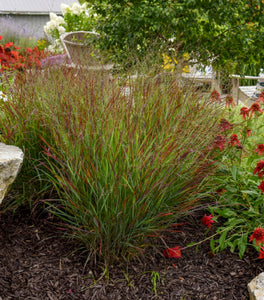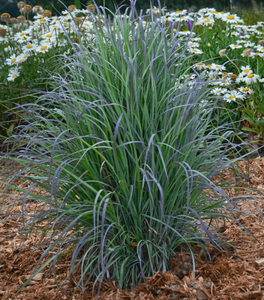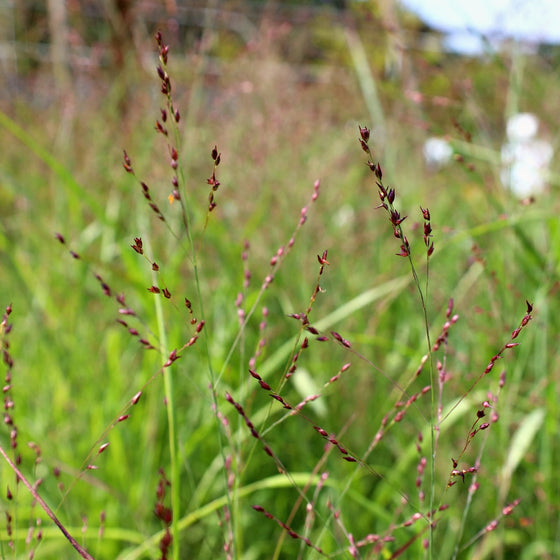
Images Depict Mature Plants
Panicum Shenandoah Switch Grass for Sale Online
Shenandoah Switch Grass (Panicum virgatum 'Shenandoah') is a stunning native ornamental grass that adds year-round interest to your garden with its beautiful, compact growth habit and vibrant foliage. Known for its narrow, upright form, Shenandoah Switch Grass starts the season with green leaves that gradually take on striking burgundy-red hues as summer progresses, intensifying to deep shades by fall. In late summer, delicate, airy, pinkish-red flower panicles emerge above the foliage, creating a soft, graceful appearance and providing valuable food for wildlife. This warm-season grass grows to about 3-4 feet tall, making it an excellent choice for adding texture, color, and height to a variety of garden settings.
Shenandoah Switch Grass is highly versatile, thriving in a range of conditions, from full sun to partial shade, and tolerates different soil types, including clay and sandy soils. It is also drought-tolerant once established, making it a low-maintenance option for waterwise gardens. As a native North American species, Shenandoah Switch Grass is well-adapted to local climates and provides critical support to native wildlife, attracting birds and beneficial insects to your garden. Its compact size and colorful foliage make it an ideal choice for borders, mass plantings, rain gardens, or as a focal point in mixed perennial beds.
In addition to its beauty, Shenandoah Switch Grass offers practical benefits, such as erosion control for slopes and a strong resistance to deer browsing. The rustling sound of its upright blades in the breeze adds a serene, natural ambiance to outdoor spaces. Whether planted in a formal landscape or a naturalistic prairie-style garden, Shenandoah Switch Grass brings vibrant, four-season appeal with its changing foliage colors and graceful flower heads, making it a standout choice for gardeners looking to add texture and movement to their landscape.
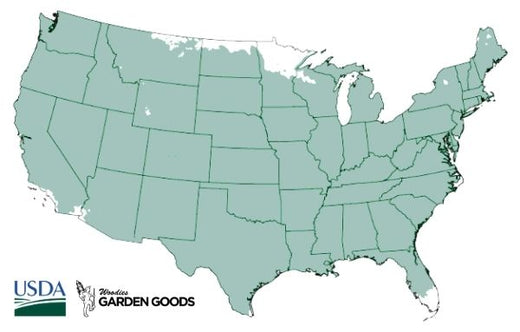
| Hardiness Zone: | 4-9 |
|---|---|
| Mature Height: | 4 to 5 Feet |
| Mature Width: | 2 Feet |
| Sunlight: | Full sun |
| Water Requirements: | Average to wet |
| Selling Points: | Erosion control, native, deer resistant, drought tolerant, salt tolerant, fall interest |
How to Care for Shenandoah Switch Grass
Before you buy Shenandoah Switch Grass, make sure to read about the recommended care instructions to keep this plant healthy and thriving.
How do I plant Shenandoah Switch Grass?
To plant Shenandoah Switch Grass (Panicum virgatum 'Shenandoah'), begin by selecting a location that receives full sun, as this will ensure optimal growth and the best foliage color. Shenandoah Switch Grass thrives in well-drained soil, but it is highly adaptable and can tolerate a range of soil types, including clay and sandy soils. To plant, dig a hole twice the width of the root ball and just as deep. Gently remove the plant from its container, loosen the roots, and place the switch grass in the hole, making sure the top of the root ball is level with the ground surface. Fill in the hole with soil, tamping it down lightly to remove air pockets, and water thoroughly to help the plant establish. After planting Shenandoah Switch Grass, space multiple plants about 18 to 24 inches apart to give them enough room to spread and create a lush, full look. Adding a 2-3 inch layer of organic mulch around the base of the plant can help retain moisture, suppress weeds, and regulate soil temperature. However, make sure to keep the mulch a few inches away from the crown to avoid rot. During the first growing season, water regularly to keep the soil evenly moist, but not waterlogged, as this will help the plant establish strong roots. Once established, Shenandoah Switch Grass is drought-tolerant and requires minimal watering, making it an excellent choice for low-maintenance, native gardens or naturalistic landscapes that support local wildlife.
How do I water Shenandoah Switch Grass?
To water Shenandoah Switch Grass (Panicum virgatum 'Shenandoah'), it's important to maintain consistent moisture during the first growing season to help establish a strong root system. Immediately after planting, water the grass thoroughly to help settle the soil and eliminate air pockets. For the first few months, water the plant deeply once or twice a week, especially during hot or dry spells, to ensure the soil remains consistently moist but not waterlogged. Deep watering encourages the roots to grow down into the soil, which helps the grass develop resilience to drought conditions in the future. However, always let the top few inches of soil dry out between waterings to avoid root rot. Once established, Shenandoah Switch Grass becomes quite drought-tolerant and will only need supplemental watering during prolonged dry periods. Typically, natural rainfall will suffice, but during extremely hot weather or extended drought, consider giving the grass a deep soak every few weeks. Be careful not to overwater, as Shenandoah Switch Grass prefers well-drained soil and can handle periods of dryness better than standing water. Mulching around the base of the plant helps to retain moisture and regulate soil temperature, making watering more efficient. Proper watering practices will ensure Shenandoah Switch Grass thrives, producing vibrant burgundy-red foliage and airy flower panicles that enhance your garden's beauty.
How do I Fertilize Shenandoah Switch Grass?
To fertilize Shenandoah Switch Grass (Panicum virgatum 'Shenandoah'), apply a light feeding in early spring as new growth starts to emerge. Use a balanced, slow-release fertilizer with an N-P-K ratio like 10-10-10, which provides the essential nutrients needed for healthy root development and vibrant foliage. Spread the fertilizer evenly around the base of the plant, but keep it a few inches away from the crown to avoid burn. After applying the fertilizer, water thoroughly to help the nutrients reach the root zone and stimulate vigorous growth. In most cases, one application in early spring is sufficient to maintain the health and beauty of your switch grass throughout the growing season. If you prefer a more organic approach, top-dress the soil with compost or well-aged manure in the spring. This will enrich the soil and release nutrients gradually, supporting consistent growth without the risk of over-fertilizing. Shenandoah Switch Grass naturally thrives in nutrient-poor soils, so avoid using high-nitrogen fertilizers, as excessive nitrogen can lead to overly lush growth that may cause the grass to flop over. By fertilizing sparingly, you can ensure your Shenandoah Switch Grass grows upright and maintains its vibrant burgundy-red foliage and graceful flower panicles, making it a stunning feature in your landscape while requiring minimal maintenance.

How do I prune Shenandoah Switch Grass?
Pruning Shenandoah Switch Grass (Panicum virgatum 'Shenandoah') is an important part of maintaining its health, appearance, and encouraging fresh growth each year. The best time to prune Shenandoah Switch Grass is in late winter or early spring, just before new growth begins. During this time, cut back the old stems to about 3-4 inches above the ground using sharp pruning shears or hedge trimmers. Removing the old, dried stems will allow new shoots to emerge without obstruction, ensuring a tidy and vigorous growth habit. Pruning before the new growth starts also helps prevent damaging the fresh shoots, keeping the plant looking lush and full throughout the growing season. In addition to the annual late-winter prune, you can also remove any broken or damaged stems during the growing season to maintain a neat appearance. Shenandoah Switch Grass is a warm-season grass, so cutting it back early helps preserve its attractive upright structure while ensuring that the plant remains healthy and vigorous. Allowing the old foliage to stay throughout the winter adds visual interest to the garden, especially when the grass takes on a golden color, and provides shelter for wildlife. By properly pruning Shenandoah Switch Grass each year, you'll encourage healthy growth and enjoy its beautiful burgundy-red foliage and airy flower panicles, making it a stunning addition to your landscape that provides four-season interest.

